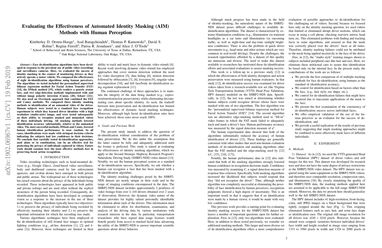Evaluating the Effectiveness of Automated Identity Masking (AIM) Methods with Human Perception and a Deep Convolutional Neural Network (CNN)
Face de-identification algorithms have been developed in response to the prevalent use of public video recordings and surveillance cameras. Here, we evaluated the success of identity masking in the context of monitoring drivers as they actively operate a motor vehicle. We studied the effectiveness of eight de-identification algorithms using human perceivers and a state-of-the-art deep convolutional neural network (CNN). We used a standard face recognition experiment in which human subjects studied high-resolution (studio-style) images to learn driver identities. Subjects were tested subsequently on their ability to recognize those identities in low-resolution videos depicting the drivers operating a motor vehicle. The videos were in either unmasked format, or were masked by one of the eight de-identification algorithms. All masking algorithms lowered identification accuracy substantially, relative to the unmasked video. In all cases, identifications were made with stringent decision criteria indicating the subjects had low confidence in their decisions. When matching the identities in high-resolution still images to those in the masked videos, the CNN performed at chance. Next, we examined CNN performance on the same task, but using the unmasked videos and their masked counterparts. In this case, the network scored surprisingly well on a subset of mask conditions. We conclude that carefully tested de-identification approaches, used alone or in combination, can be an effective tool for protecting the privacy of individuals captured in videos. We note that no approach is equally effective in masking all stimuli, and that future work should examine possible methods for determining the most effective mask per individual stimulus.
PDF Abstract



